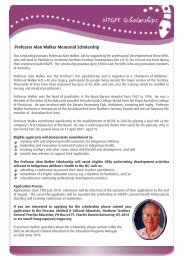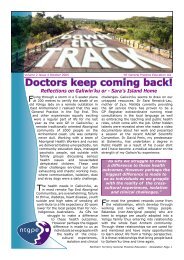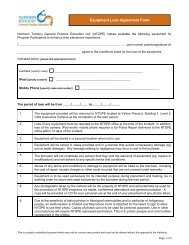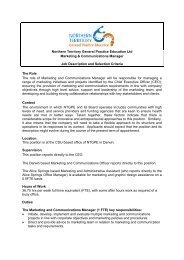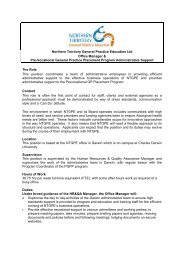Using Simulation in Primary Care Training - ntgpe
Using Simulation in Primary Care Training - ntgpe
Using Simulation in Primary Care Training - ntgpe
Create successful ePaper yourself
Turn your PDF publications into a flip-book with our unique Google optimized e-Paper software.
<strong>Us<strong>in</strong>g</strong> <strong>Simulation</strong> <strong>in</strong> <strong>Primary</strong><strong>Care</strong> Tra<strong>in</strong><strong>in</strong>gDr Tams<strong>in</strong> Cockayne – Director of Medical and Cultural EducationDr Mark Cavill – Medical EducatorIrwyn Shepherd – <strong>Simulation</strong> Technical AdvisorNTGPE , AustraliaMarch 2012
Community Health Center of Cape Cod is a non-profit Federally Qualified Health Center thatprovides access to health care for adults and children with MassHealth, Commonwealth <strong>Care</strong>,Medicare, private <strong>in</strong>surance, or no <strong>in</strong>surance at all. Services <strong>in</strong>clude primary and preventivecare, dental care, behavioral health, coord<strong>in</strong>ated case management, and prescription assistance,at locations <strong>in</strong> Falmouth, Mashpee and Bourne. Visit the Health Center onl<strong>in</strong>e atchcofcapecod.orgPhoto attached####
What is <strong>Simulation</strong>?• Small Group Discussion– Def<strong>in</strong>e <strong>Simulation</strong>– Have you ever used it as a teach<strong>in</strong>g orlearn<strong>in</strong>g tool? – life/healthcare– How might you use it <strong>in</strong> <strong>Primary</strong> Health<strong>Care</strong> <strong>in</strong> the NT?
What is Patient <strong>Simulation</strong> (PS)?“simulation is a technique – not a technology –to replace or amplify real experiences withguided experiences, artificially contrived, thatevoke or replicate substantial aspects of thereal world <strong>in</strong> a fully <strong>in</strong>teractive manner”Gaba, DM: (2004) The future vision ofsimulation <strong>in</strong> healthcare, Quality <strong>in</strong>Safety and Health <strong>Care</strong>, 13: pp. i2 - i10
Types of simulation• Mannik<strong>in</strong> vs real people• High fidelity vs low fidelity
Why use <strong>Simulation</strong> <strong>in</strong> Healthcare?• More dynamic learn<strong>in</strong>g environment• Helps close the theory - practice gap• Helps us practice th<strong>in</strong>gs we rarely see <strong>in</strong>practice and get good at them, safely
Kolb and Miller examplesKolb’s Learn<strong>in</strong>g Cycle
Kolb and Miller examplesMiller’s Pyramid
Monsters Inc <strong>Simulation</strong>
Develop<strong>in</strong>g a <strong>Simulation</strong>Learn<strong>in</strong>g PlanObjectives of the session• what are critical th<strong>in</strong>k<strong>in</strong>g po<strong>in</strong>ts & decision steps youwant to see done / consideredSet UpScript• sett<strong>in</strong>g the scene, sett<strong>in</strong>g the rules• equipment you need, fidelity• how much <strong>in</strong>fo• obs, progressionTim<strong>in</strong>g• Setup / scenario length / feedback
Learn<strong>in</strong>g Outcomes (LO)What are Learn<strong>in</strong>g Outcomes (LO)?Outcomes are usually expressed as knowledge,skills, attitudes or valuesWhat are the characteristics of good LO?They specify an action by the student that must beobservable, measurable and able to bedemonstrated!
Exercise 1As a group develop a scenarious<strong>in</strong>g the template provided
Debrief<strong>in</strong>g: WhyReflective Learn<strong>in</strong>gTransfer experienceto real lifeSupportiveExperiential /Emotional
Debrief<strong>in</strong>g: How• Discuss strengths first• Then weaknesses• Identify goals for improvement• Cover any special moments• L<strong>in</strong>k events to the real world• Two way process
Debrief<strong>in</strong>g: How (2)A Basic StructureVent<strong>in</strong>gDescriptive PhaseAnalytical PhaseGeneralisation
Debrief<strong>in</strong>g:Vent<strong>in</strong>gDescriptive PhaseAnalytical PhaseGeneralisation• Emotional energy• Ground Rules• Clarify what you want to achievefrom the debriefHow do you feel now?What was it like <strong>in</strong> thescenario?
Debrief<strong>in</strong>g:Vent<strong>in</strong>gDescriptive PhaseAnalytical PhaseGeneralisation• Summary of the events – learneror leader• Chronological order• Orig<strong>in</strong>al problems, assessment,treatments“Can you summarise theevents of the scenario andwhat you did”Engage the rest of the group
Debrief<strong>in</strong>g:• Bulk of timeVent<strong>in</strong>gDescriptive PhaseAnalytical PhaseGeneralisation• Participants analyse the events• Identify strengths first, thenimprovements• Analyse medical / technical /participant engagement• Any salient moments‘’What did you do well <strong>in</strong>this scenario – why?’’‘’Anyth<strong>in</strong>g you would youwould do differently?’’
Debrief<strong>in</strong>g:Vent<strong>in</strong>gDescriptive PhaseAnalytical PhaseGeneralisation• Generalis<strong>in</strong>g what was learnt tothe next scenario.• Relat<strong>in</strong>g to the workplace, past /future.“Have you taken someth<strong>in</strong>g newaway from the scenario?”“Will this change any aspect of yourpractice at work tomorrow?”“What have you learnt?”
Summary• Create a safe learn<strong>in</strong>g environment• Have a structure• Be Learner not Teacher Centred• Positive experience• Keep to time
Exercise 2In your groups th<strong>in</strong>k about some waysyou might debrief your scenario
Exercise 3Time to run a scenario



